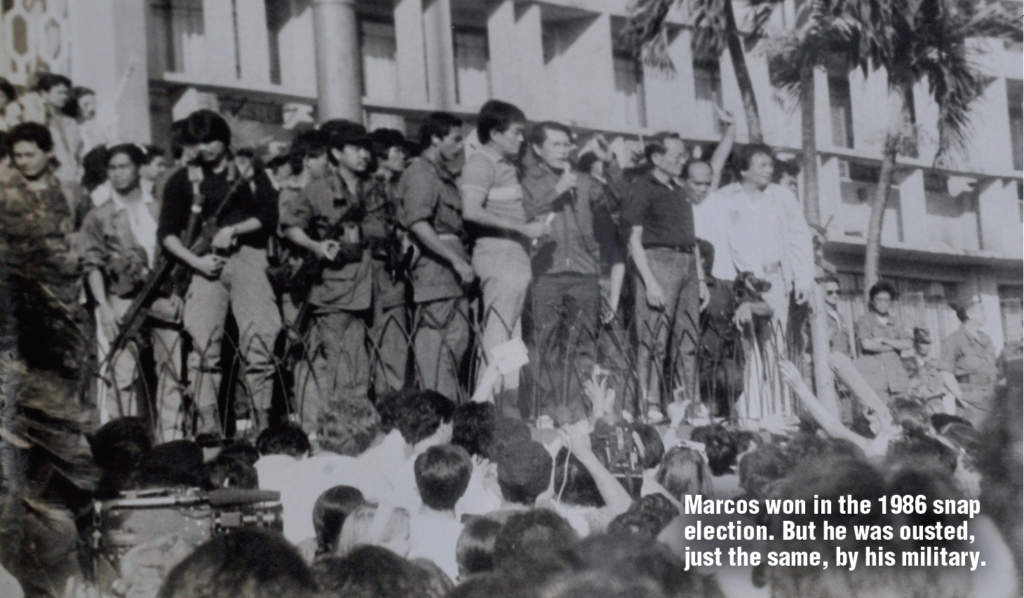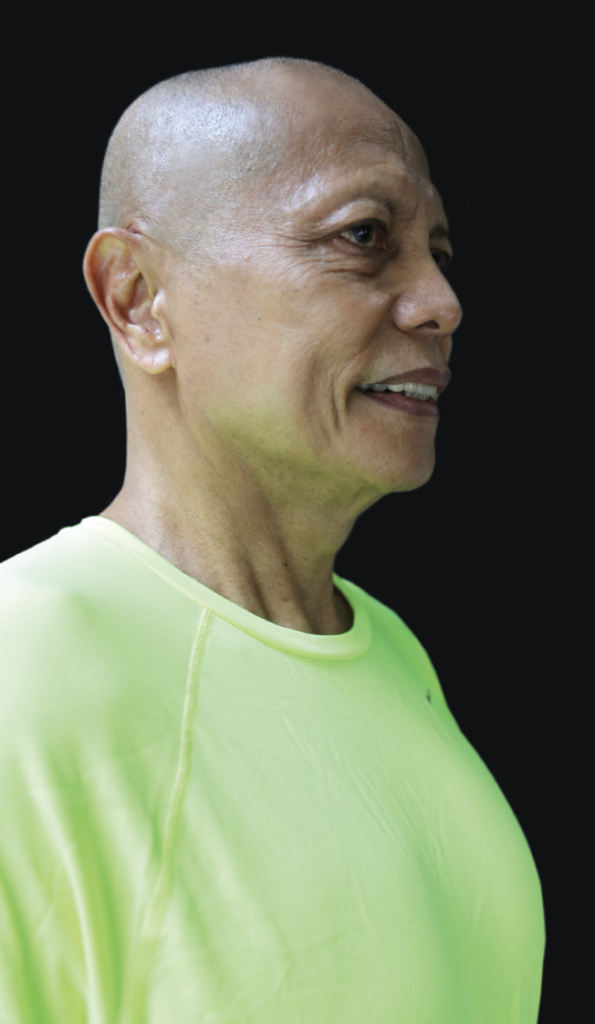By Antonio S. Lopez

There has been so much hype and hoopla about the two EDSAs—EDSA I and EDSA II.
EDSA I is the Feb. 22 to 25, 1986 People Power that ousted Ferdinand Marcos and installed Corazon Cojuangco Aquino.
EDSA II is the Jan. 20, 2001 church- and NGO-backed military coup that ousted Joseph Estrada and installed Gloria Macapagal Arroyo.
I covered not one, not two, but three EDSAs. Col. Ariel O. Querubin, the fabled Marines officer, participated in both EDSA I and EDSA II, and indirectly, in EDSA III.
The legend of the Marines
The Marines, of course, have been the best trained and the fightingest men of the Armed Forces of the Philippines. They can defy the ebb and flow of the tide of any battle, and still triumph. Querubin epitomized the grit, endurance and courage of the best in soldiery, which the Marines exemplified.
There was a third EDSA, the May 1, 2001 popular and pedestrian uprising that nearly ousted Mrs. Arroyo were it for the effective sniping job done by the military and the police on the protesters.
Nobody knows for sure how many people died or were killed by the military to protect the palace from a hoi polloi revolt. Nobody remembers about this 2001 EDSA III anymore. To me, EDSA III was the most spontaneous and most genuine of the three revolts. But it was foiled by the military, by Gloria Macapagal Arroyo’s military. For that reason perhaps, GMA sometimes addresses Colonel Querubin, fondly, as “my hero”.
EDSA I triggered by greed
Not many people know it but EDSA I was triggered by greed and was won by a lie.
The crowds that massed at EDSA on February 24, Monday, and February 25, Tuesday, 1986, were there not to stage a revolt but to a hold a picnic. June Keithley had announced on radio at 7 a.m. of February 24, 1986 that the Marcoses had left. It was a lie. In their glee and feeling that finally it was all over, people trooped to EDSA to celebrate.
The greed arose from a Chinese forex trader who violated the peso-dollar trading band imposed by then unofficial central bank, the Binondo Central Bank managed and headed by then Trade and Industry Secretary Roberto V. Ongpin.
Ongpin had the erring trader arrested and loaded into a van. Unfortunately, the forex trader died. Unfortunately again, the trader happened to be a man of then Armed Forces chief Fabian C. Ver. Angered, the dreaded military chief had 19 of Ongpin’s security men arrested. They were marching in full battle gear and dressed in SWAT uniform at about 4 a.m. inside Fort Bonifacio when arrested on Feb. 22, 1986, a Saturday.
Querubin was supposed to make the arrest
On Wednesday, Feb. 19, 1986, Col. Ariel Querubin was assigned to arrest the 19 Ongpin security men under Mike Asperin, bring them to El Fraille Island at the mouth of Manila Bay, and eliminate them. Querubin disobeyed the orders. By that time, Defense Minister Juan Ponce Enrile’s long brewing coup plot had been discovered. Ariel’s act of defiance changed the course of history.
“Patchy but recurrent reports provoked suspicions that RAM was set to mount a coup,” recalls Querubin, then a Marine Captain. “We learned that on Feb. 19, 1986, in what looked like a dress rehearsal, 19 men detailed to Trade and Industry Minister Roberto Ongpin and led by a navy lieutenant conducted a night run on the Fort Bonifacio naval grounds.”
Ariel’s narration
Here’s how Ariel narrates what happened next on Feb. 19, 1986:
“Called to an inquiry, the commander of the Military Police for the Marines, Captain Benjamin Dolorfino, not only confirmed the night run, but let on that it was the first of two, the next one set for two nights later, and that both runs had been cleared by the operations officer of the naval station, Navy Captain Pablo Ong. Surely the night runners could not have acted with such confidence if they had no well-placed contacts inside the camp.”
“The trap was laid on Feb. 21, 1986. At about 10 p.m., on a stretch of road between the Marine headquarters and the Bachelors Officers Quarters. With me was 2nd Lieutenant Alexander Balutan on OJT with the office. We shined our searchlights on the night-runners and warned they were surrounded. The men froze in their tracks. Their leader, Lieutenant Junior Grade Michael Asperin, walked up to tell me they were men of ‘Vulcan,’ the call sign of Colonel Honasan, apparently hoping to make an impression. It did.”

“I told him (Asperin), it was precisely the reason we were bringing them in. According to my boss, Lieutenant Colonel Jorge Floro, Malacañang’s order to his own boss, Colonel Guillermo Ruiz, assistant chief for intelligence, was to take the night-runners to El Fraille, an outcrop of land in the waters of Cavite province, somewhere between Naic town and Carballo Island, near Corregidor.”
El Fraille used for summary executions
“Sea navigators used El Fraille as a reference point; but, according to credible talk, police and military enforcers used it for summary executions. I myself had not been there. Anyway I decided on my own to take the captives to the camp’s firing range, for questioning. Intelligence operatives promptly worked on them and deduced that their role was to snatch the flag officer in command, Rear Admiral Brilliante Ochoco, and the Marine commandant, Brigadier General Artemio Tadiar (a brother-in-law of Floro’s), thus neutralizing their commands.”
“That same night Brigadier General Tadiar left an order for the airlift of the 5th Marine Battalion from the south to reinforce the defense of Malacañang before proceeding there himself with Colonel Ruiz to apprise the armed forces chief, General Fabian Ver. They took my car to avoid being compromised, and came back with an order from Ver to raid the RAM headquarters in Aguinaldo, the armed forces camp, and arrest the RAM leaders.”
Crackdown begins in the Palace
“In Malacañang itself, a crackdown had begun, and my own cousin Major Allen Querubin was among the first arrested, along with Captain Ricardo Morales, for their ties to Honasan. Both were with the Presidential Security Command.”
“Also taken were three top plotters – Lieutenant Colonel Marcelino Malajacan, Lieutenant Colonel Ricardo Brillantes, and Major Saulito Aromin, battalion commanders all. That earned me the promise from Colonel Ruiz of a recommendation for a temporary promotion to major, while most of my classmates were still working for their captainship. I didn’t think much of it, and just as well; with Marcos’s fall, the promise, as with all promises made in his name, would prove empty.”
At 11 a.m., Saturday, Feb. 22, 1986, at the Ministry of Trade and Industry, Ongpin went looking for his security men. He called up then Minister Enrile who was with the Club 365 at the Atrium in Makati.
Enrile thought the arrest of the 19 Ongpin security men, who turned out to be RAM Boys of Col. Gringo Honasan, was part of the crackdown against the plot to oust Marcos. The putsch was being planned by Enrile and his RAM Boys as far back as 1982.
The defense chief had grown disenchanted with Marcos, who was very ill, and become wary of the cabal led by Ver and the First Lady, Mrs. Imelda Romualdez Marcos.
The Largest Weekly News and Business Magazine
Saturday afternoon (Feb. 22, 1986), Enrile summoned his boys to his house on Morada Street, Dasmariñas Village. There they plotted their next moves. They decided to make a last stand at the armed forces headquarters Camp Aguinaldo in Quezon City.
FVR’s role
At 2 p.m., Enrile called then Vice Chief of Staff Lt. Gen. Fidel V. Ramos. “Are you with us?” JPE asked Eddie. “I am with you all the way,” the latter assured.
It was not until late in the evening that Saturday that Ramos actually joined the rebellion at Camp Aguinaldo. He had contacted his loyal PC-INP commanders, like Rene de Villa in Bicol, and Rodrigo Gutang in Cagayan de Oro and found to his dismay no troops could be readily sent to Manila to reinforce Enrile’s men, then numbering less than 50, undermanned and under-armed.
Corazon Cojuangco Aquino learned about the brewing rebellion at 4 p.m. Saturday in Cebu. She led a destabilization and boycott rally there. I was there. I was covering the protest rally. After hearing about rumors of the defection, I went to the Mactan airport to book a flight to Manila. I landed in Manila shortly after 9 p.m. With Boy del Mundo of then UPI, I took a taxi to Camp Aguinaldo.
I was surprised to find the camp commander welcoming us with open arms. Enrile and Gringo had no troops at that time. Enrile had made a deal with Marcos—No shooting on the first night. Also, foreign correspondents were to be allowed inside Camp Aguinaldo.
Inside the Defense Ministry headquarters, Enrile and Ramos were giving an extended press conference. I Asked if Cory Aquino called them up, Enrile said yes. “What can I do for you?” she asked. “Nothing, just pray,” Enrile replied.
Marcos won the snap election of 1986
A recount of the votes, by Namfrel, after Cory took over, showed Marcos was the real winner of the February 1986 snap election, not by two million votes, as canvassed by the Batasan, but by 800,000 votes as recounted by Namfrel. In the Comelec official count, Marcos won the reelection by a margin of 1.7 million votes over Cory.
The wily strongman was surprised by the propaganda tactics of the anti-Marcos forces. The wives of the RAM boys led the Feb. 21, 1986 walkout at the Tabulation Center that was counting the votes in the 1986 snap elections.
Today, as the country prepares to choose the successor to Rodrigo Duterte, Ferdinand “Bongbong” Marcos Jr. leads nearly all surveys, with 50 to 62% of possible votes. His nearest rival, Vice President Leni Robredo, is behind with just 15 to 20% of the vote.
But as in EDSA I, EDSA II, and EDSA III, victory does not always go to the winner in the electoral count.
There is the military to reckon with. And officers with the mien and mettle of Colonel Querubin’s caliber to make the crucial decisions that change history’s course.
READ FULL ARTICLE HERE:
